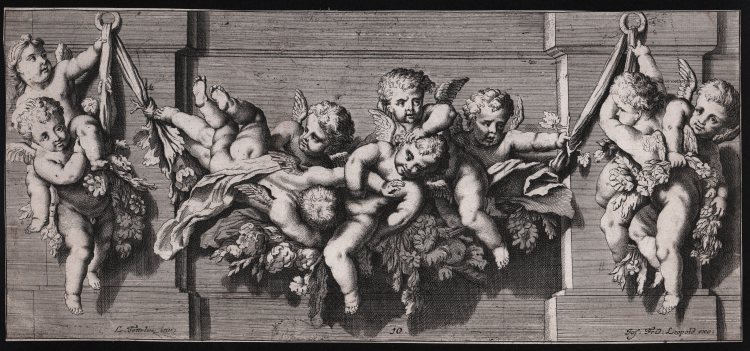




| Reference: | S44715 |
| Author | Joseph Friedrich Leopold |
| Year: | 1690 ca. |
| Measures: | 395 x 180 mm |



| Reference: | S44715 |
| Author | Joseph Friedrich Leopold |
| Year: | 1690 ca. |
| Measures: | 395 x 180 mm |
Engraving, late 17th century, signed lower right with editorial imprint.
From a subject by Louis Testelin (1615-1655) already translated into print by Louis Ferdinand in the collection Diuers objets d'Amour, designez en sorte qu'il pourront seruir en diuers lieux, d'ornemens, et de decorations ... Dessigne par L. Tettelain, et graué par L. Ferdinand ... A Paris chez P. Ferdinand.
This is a German replica, in counterpart, published in Augsburg by Leopold.
Beautiful proof, richly toned, printed on contemporary laid paper, trimmed to copperplate, traces of color on verso, otherwise in very good condition.
Joseph Friedrich Leopold (1668-1727)
|
Joseph Friedrich Leopold (also: Josef, Iosef; Latinized as Josephus Fridericus Leopoldus; * 1668 in Marktredwitz; † February 6, 1727 in Augsburg) was a German copperplate engraver and music engraver, as well as publisher and art and music dealer, based "auf dem Obst Marck" (1703) 'in der Kohlergasse.
Leopold arrived in Augsburg in 1689. He had been married since April 21, 1698, to Eleonora Magdalena Steudner, daughter of Augsburg copperplate engraver and art publisher Philipp Steudner. He was the father of engraver and publisher Johann Christian Leopold. Beginning in 1695 Leopold made a lasting name for himself as an engraver. He founded a sheet music publishing house, which his son soon expanded to become the most important in Augsburg in the first half of the 18th century. The importance of the company's founder, however, lies mainly in the early "dissemination of copied or imitated foreign ornamental forms," which he published in the form of pattern books, thus fostering the flowering of illustrated prints in Germany.
Leopold collaborated with various artists and craftsmen, such as Johann Andreas Thelott, Albrecht Biller, and Balduin Drentwett. In 1719 Leopold took over the Augsburg publishing house from Johann Ulrich Krauß; in 1723 he began a series of partially colored city views; in the period between 1710 and 1750, the publishing family published 221 prints and city views.
The German Book and Type Museum of the German National Library lists Leopold among the colored paper manufacturers in its holdings under the heading Paper History Collections. According to Haemmerle, he produced "Turkish paper" and other colored papers; for this reason he had "disputes about copying with Jakob Johann Crespi. In 1726 he received an imperial privilege for his metallized papers. Haemmerle considered his brocaded papers, "especially those with chinoiserie," among the best products of their kind.
|
Joseph Friedrich Leopold (1668-1727)
|
Joseph Friedrich Leopold (also: Josef, Iosef; Latinized as Josephus Fridericus Leopoldus; * 1668 in Marktredwitz; † February 6, 1727 in Augsburg) was a German copperplate engraver and music engraver, as well as publisher and art and music dealer, based "auf dem Obst Marck" (1703) 'in der Kohlergasse.
Leopold arrived in Augsburg in 1689. He had been married since April 21, 1698, to Eleonora Magdalena Steudner, daughter of Augsburg copperplate engraver and art publisher Philipp Steudner. He was the father of engraver and publisher Johann Christian Leopold. Beginning in 1695 Leopold made a lasting name for himself as an engraver. He founded a sheet music publishing house, which his son soon expanded to become the most important in Augsburg in the first half of the 18th century. The importance of the company's founder, however, lies mainly in the early "dissemination of copied or imitated foreign ornamental forms," which he published in the form of pattern books, thus fostering the flowering of illustrated prints in Germany.
Leopold collaborated with various artists and craftsmen, such as Johann Andreas Thelott, Albrecht Biller, and Balduin Drentwett. In 1719 Leopold took over the Augsburg publishing house from Johann Ulrich Krauß; in 1723 he began a series of partially colored city views; in the period between 1710 and 1750, the publishing family published 221 prints and city views.
The German Book and Type Museum of the German National Library lists Leopold among the colored paper manufacturers in its holdings under the heading Paper History Collections. According to Haemmerle, he produced "Turkish paper" and other colored papers; for this reason he had "disputes about copying with Jakob Johann Crespi. In 1726 he received an imperial privilege for his metallized papers. Haemmerle considered his brocaded papers, "especially those with chinoiserie," among the best products of their kind.
|